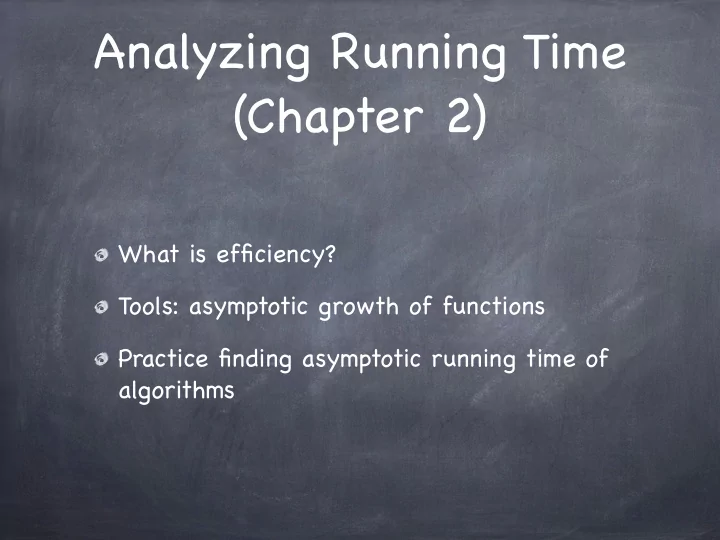

Analyzing Running Time (Chapter 2) What is efficiency? Tools: asymptotic growth of functions Practice finding asymptotic running time of algorithms
First: a bit of sorting Which of these grows faster? n 4/3 n(log n) 3 Example(s) on board
Bean Counting 101: Analyze Gale-Shapley Initialize each college and student to be free. while (some college is free and hasn't made offers to every student) { Choose such a college c s = 1 st student on c’s list to whom c has not made offer if (s is free) assign c and s to be engaged else if (s prefers c to current college c’) assign c and s to be engaged, and c’ to be free else s rejects c }
Bean Counting Count how many lines of code execute Be wary of pseudocode: make sure each line is really O(1) May need to think carefully about data structures to determine if this is the case
Four Patterns For Loops Accounting Enumeration Divide-and-(maybe)-conquer
Pattern 1: For Loops Compute the maximum max = a 1 for i = 2 to n { for i = 2 to n { for j = 2 to n { if (a i > max) // constant time max = a i // operations } } O(n) O(n 2 )
Pattern 2: Accounting For while() loops or more complex constructions, may not be obvious how many times a line of code executes Use accounting scheme to count executions
Accounting: Gale-Shapley Initialize each college and student to be free while (some college is free and ...) { // // etc., etc. // } Each loop execution makes a new offer. Charge each loop to an offer! --> at most n 2 times through loop
Accounting: Merge Sorted Lists Input: sorted lists A = a 1 ,a 2 ,…,a n and B = b 1 ,b 2 ,…,b n Output: combined sorted list
Accounting: Merge Two Sorted Lists i = 1, j = 1 while (both lists are nonempty) { if (a i ≤ b j ) { append a i to output list increment i Accounting } scheme? else { append b j to output list increment j } } append remainder of nonempty list to output list
Pattern 3: Enumeration Brute force solution: examine all possibilities Running time will depend on the structure of the problem. How many possible answers are there? (Seems ugly, but sometimes the best we can do!)
Closest Points Closest pair of points in a plane Given a list of n points in the plane (x 1 , y 1 ), …, (x n , y n ), find the pair that is closest. min = infinity for i = 1 to n { for j = i+1 to n { O(n 2 ) d = (x i - x j ) 2 + (y i - y j ) 2 if (d < min) min = d } }
More Enumeration Examine all ____ of n items Pairs - O(n 2 ) Triples - O(n 3 ) Subsets of size k - O(n k ) Subsets of any size - O(2 n ) Permutations - O(n!)
Pattern 4: Divide-and-(maybe)-conquer O(log n) “logarithmic time”. Do a constant amount of work to discard a constant fraction of the input (often 1/2 ) Binary search (illustrate on board) O(n log n). Divide-and-conquer (much more later in course) Mergesort
Mergesort 13 17 6 3 9 2 16 1 Divide 13 17 6 3 9 2 16 1 13 17 6 3 9 2 16 1 13 17 3 6 2 9 1 16 Sort 3 6 13 17 1 2 9 16 Conquer 1 2 3 6 9 13 16 17
Summary Bean counting: count each line, be careful of pseudocode Patterns: for loops, accounting, enumeration, divide-and-maybe-conquer Common running times O(log n), O(n), O(n log n), O(n 2 ), O(2 n ), O(n!)
Recommend
More recommend